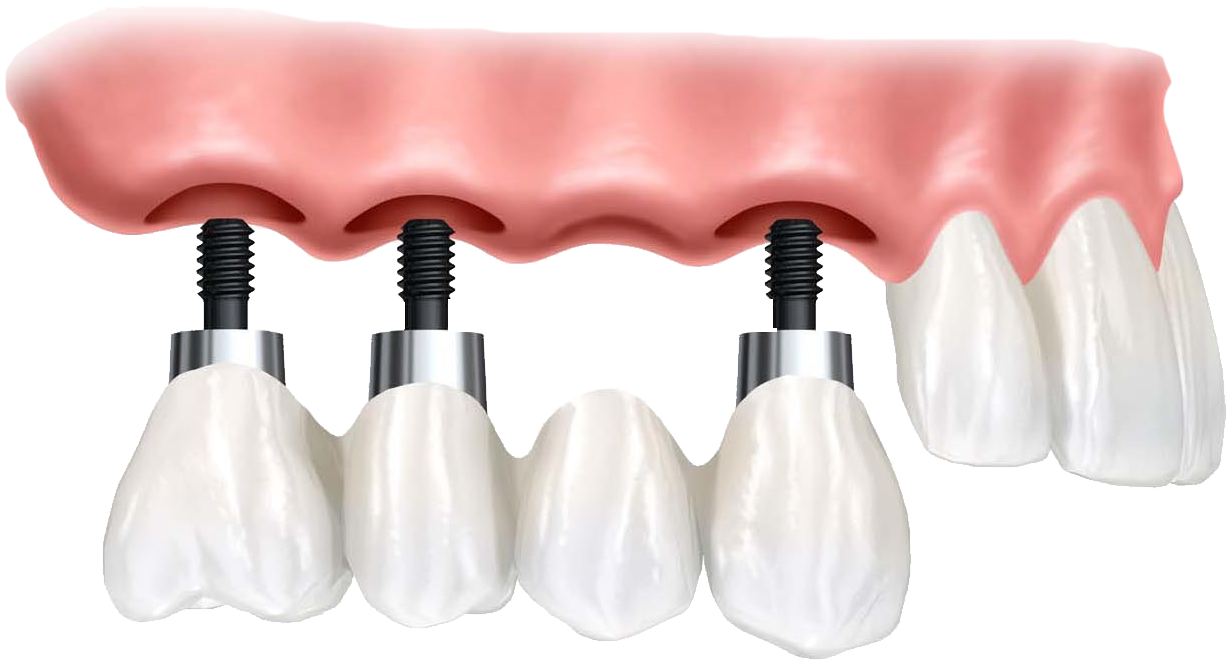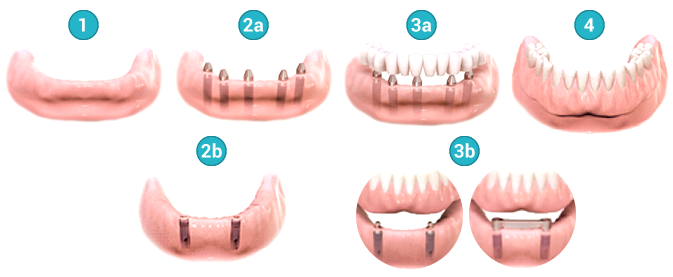Implant Treatment
Dental implant is the name given to titanium structures placed in the jawbone to restore the function and aesthetics of one or more missing teeth. Thanks to these structures, our patients have the closest function to natural teeth.

What is the Implant?
'Dental Implant' is the name given to titanium structures placed in the jawbone to restore the function and aesthetics of one or more missing teeth. Thanks to these structures, our patients have the closest function to natural teeth.
Lack of a Single Tooth

1. The need to eliminate the lack of single tooth may be due to tooth loss as a result of accidents or may occur as a result of the absence of congenital teeth at all. In such cases, permanent results are obtained by placing dental implants after completing the development of the jawbone.
2. A dental implant is placed in the jawbone. Neighboring intact teeth are not affected and damaged by dental implants in any way, however, tipping can be seen in neighboring teeth used as dental bridgework pillars in alternative solutions such as other bridgework applications.
3. The abutment is attached to the dental implant. Following this, a crown that is in perfect harmony with the gingiva is placed on the healing cap.
4. The new tooth is now ready and has a natural appearance that cannot be distinguished from other existing natural teeth in any way.
Lack of a Few Teeth

1. Some people have tooth loss in the posterior region of the jaws. This is often seen in gingival diseases or tooth fractures that can occur due to fillings made on the teeth.
2. Dental implant bridges are made on two or four dental implants. Permanent teeth of the patient are not affected by this situation. In addition, these bridges function for many years regardless of the conditions of other teeth present in the mouth.
3. Abutments are attached to dental implants. The next step is to install the bridge; The new set of teeth is placed on the abutments.
4. The dental implant bridge has now taken its place in the mouth and is durable enough to resist strong chewing forces in the posterior region of the mouth. In fact, it feels and functions like normal teeth in the mouth.
Lack of All Teeth

1. If you have lost all your teeth in both jaws in your mouth, you may prefer permanent fixed implant bridges or total dentures that can be fitted on at least two implants. Removable dentures planned in this way are more stable than conventional removable dentures. However, the most natural solution is the situations where permanent fixed implant bridges are located in the mouth.
2a. In the construction of permanent fixed implant bridges, several dental implants are placed in order to create a solid infrastructure. As a result of the attachment of dental implants to the jawbone, forces are transmitted to the jawbone exactly and the bone is stimulated as normal; Thus, healthy bone levels and facial structures are preserved.
2b. By placing at least two implants in removable dentures, it is ensured that the dentures is attached to intact tissues.
3a. After the healing caps are attached to the implants, the bridge is adapted and the dentures is finalized according to your desires.
3b. In removable dentures, a small bar is used between ball-shaped abutments or abutments. The counterpart of the selected part is placed on the lower surface of the dentures.
4. Dental implant bridge and removable dentures are now ready in the mouth. They look and function like natural teeth. Now you can easily eat whatever you want or you do not have to worry about your teeth coming out of your mouth while laughing.
Can implants be applied after every tooth loss?
If the number of missing teeth is more than 1, a single implant can serve 2 or 3 teeth, depending on the area to be implanted. What happens if the implant screw does not fuse with the bone (if it is not osseointegrated)? If the correct implant and method is used, such a possibility is almost nonexistent. This type of failure usually occurs within the first 6 months following surgery. In such a case, the implant should be removed with a procedure as easy as tooth extraction. Following the healing of the bone in this area, a new implant can be placed or one of the classical type dentures can be preferred. However, in cases where more than 2 implants are placed, the remaining implants are sufficient to serve by redesigning the dentures.
My age has advanced. Can I get implants too?
As long as the general health condition of the patient is good, there is no upper age limit to prevent implant application, but it may not be preferred to apply to very young patients whose bone development is incomplete. Implant screws are structures that have a specific thickness and width. For this reason, the jawbone in the area where the implant is to be placed must have a height and width to accept this implant screw. The quality of the existing bone is also one of the factors affecting implant success. In addition, the gingivas must be completely healthy before treatment and as long as the implant remains in the mouth.
Will it hurt?
No, if appropriate anesthesia methods are applied. During the operation, general or local anesthesia can be used according to the patient's preference. Generally, the pain that can be felt on the evening of the implant can be relieved with simple painkillers. Many patients state that this pain is not different from the pain felt after a normal tooth extraction. In cases where the treatment is completed without any problems, you will be comfortable enough not to even feel the presence of implants.
When will my dentures be fitted? What kind of dentures will it be?
The loads on the implant should be minimized during the first 3-6 months, which is the healing period, in order to ensure the complete integration of the implants with the bone (Osteointegration). However, your doctor will restore your function by making a temporary dentures suitable for you during this recovery period.
Dentures to be made on implants can be of different types depending on the nature of the case. In other words, these can be planned in a way that they can be removed by the patient for easy cleaning or can only be removed by the dentist. Both planning have advantages and disadvantages, and your physician will explain the appropriate design for you before your treatment begins.
How will I clean my implants?
Although the cleaning of the implants requires a certain learning process, it is not difficult. However, you have to devote enough time for this job. The thing to remember is that the most important factor required for this type of treatment to be successful is regular oral care.
Is implant treatment an expensive treatment?
Unfortunately yes. The import of all the materials used and the need for very high technology for healthy implant production determine the price of the treatment. However, this price is not a figure that will challenge the patients' budget. For this reason, implant applications have become a routine procedure today. However, the exact price will depend on whether your doctor examines you and determines whether you are a suitable patient for this type of treatment and the nature of the dentures you want.
What are the risks of the implant?
There is no risk beyond the risks that can be observed in all oral or female surgical procedures. These may occur as infection and allergies in the early period, and inflammation due to inadequate oral hygiene in the late period after the completion of the dentures. Smoking increases the risk of infection, especially during early recovery.
What are the advantages of implant?
1. Patients who completely lose their teeth in the lower jaw and wear a denture: These patients complain of constant pain (pounding) and not being able to chew well due to the movement of the dentures. This complaint increases with the thinning of the bone tissue that supports the dentures over time. In such patients, implant treatment eliminates all the above complaints and also stops the thinning of the bone.
2. Patients who completely lose their teeth in the lower jaw and wear a denture: Although upper dentures are more stable than lower jaw dentures, the design of the prosthesis that covers the palate can reduce the sense of taste and cause nausea.
3. Patients who have lost some of their teeth in the lower or upper jaw: The complaint of these patients can be counted as the bad appearance of the dentures held with hooks, or the necessity of cutting their healthy teeth in order to make a bridge.
4. Patients who lost a single tooth: These patients are those who have to sacrifice at least two adjacent teeth for the restoration of a single tooth. Placing a single implant not only saves neighboring teeth, but also causes more aesthetic and functional results.
What are the disadvantages of the implant?
Oral cleaning process, which should be done carefully and with time.
© 2017 All rights reserved. Dentli.com
